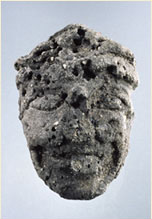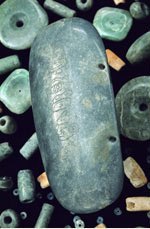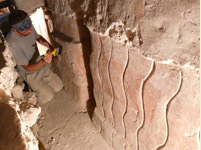Excavations in the Northern Sector of Nakum

Several years’ excavations by the Polish project were carried out in the northern, previously unexplored sector of the site, as well as in the area within the most important courtyard of the large Acropolis complex (Patio 1) in the Southern Sector of Nakum. Archaeological work in the northern part of the ruins were focused on a small pyramid called Structure 99. Before our research it had a form of a wide platform almost flat at the top, and nearly 8 m high. However, on its summit, the remains of three buildings, arranged in a triadic pattern were found. They yielded numerous vessels, complete or partially preserved axes, spearheads, figurines and other artefacts. The investigations allowed dating these buildings to the Terminal Classic (ca. 9th-10th century AD). It was a period when many Maya cities on the Southern Maya Lowlands (of south-eastern Mexico, northern and central Guatemala, Belize and western Honduras) suffered a drastic collapse, while Nakum was flourishing. Nakum’s development in these difficult times may be explained by its advantageous location on the banks of the Holmul River, which at that time was an important source of water and communication route. Nakum might have also taken advantage of the socio-politic crises that engulfed its two important and powerful neighbours: Tikal and Naranjo which were slowely being depopulated at that time. Apart of realizing extensive excavations on the summit of Structure 99 we also wanted to explore its interior in order to reconstruct its architectural history and discover possible substructures buried within its large platform. In 2007, a test-pit was opened on the summit of Structure 99, in the form of a shaft 2×2 m wide, reaching to the base of this construction. This test-pit brought the spectacular discovery of two offering deposits nearly 7 m below the summit of the pyramid (the so-called Offerings 8 and 9). These deposits contained, among other finds, nine clay heads representing Maya deities, jade ornaments including two representations of monkey heads, ceramic discs, pendants made of human bones and a cylindrical tube with two covers (most likely used as a beehive). Particularly important are the clay heads, which most probably represent the Maya gods of the Underworld. Moreover, one of the deposits (no. 9) contained a ritually broken stingray spine with a sharp, notched edge, which the Maya used for ritual bloodletting. It is very likely that the deposition of these offerings was accompanied by ritual bloodletting performed by a priest or ruler. Interestingly, both deposits date to the so-called Protoclassic period or phase (ca. 100 BC – AD 250/400). Our excavations showed that both offerings were placed on the axis of the main stairway of an older building discovered beneath Pyramid 99 and denominated as Structure 99 Sub-1. At least one of them was placed as a foundation deposit prior to the construction of Pyramid 99. To sum up, during research we were able to document 3 important phases of Str. 99: 1) the first of them denominated as 99 Sub-1 was constructed in the final part of the Late Preclassic period and consisted of a wide building located on a low platform with stairway on its southern side. Another important stage included construction of large platform nearly 6 m high during the final part of the Late Preclassic or Protoclassic. The third important moment consisted of constructing three superstructures on the summit of the platform during the final part of the Classic period. Except floors no vestiges of Early or Late Classic architecture were detected during our research.
Excavations in the Southern Sector
Pyramid 15 and the discovery of a Maya royal tomb

The activity of Polish archaeologists in the southern part of Nakum focused on the area of the largest courtyard (Patio 1) of a vast complex called the Acropolis. During earlier investigations by the Guatemalan Triángulo Project, all of the buildings enclosing Patio 1 had been explored except two small pyramids (denominated Pyramids 14 and 15), presenting very bad state of preservation and almost totally covered by the jungle. One of the most spectacular discoveries of the Polish expedition was made in 2006 season in 12-meters high Pyramid 15, situated on the eastern side of Patio1. Excavations in that place were performed to verify the hypothesis which assumed that the pyramid could have concealed a royal burial. In many Maya sites, burials of high-ranking dignitaries and rulers were often located in pyramids situated on the eastern sides of courtyards/patios. The Maya believed that the east was the direction associated with the rebirthing sun and resurrection. The hypothesis proved to be true. Exploring the summit of Pyramid 15, Polish scholars discovered a huge royal tomb. First stone slabs covering the burial chamber were lifted during the night of 6/7 June 2006. Archaeologists’ gaze fell upon vessels, remains of a skeleton and hundreds of jade ornaments, among which the most impressive and lavish object was a jade pectoral. For the Maya, jade was the most precious mineral, hence researchers often refer to it as “Maya gold”. The finds were the proof that the tomb had not been looted, even though two looters trenches were discovered in the pyramid’s eastern part. The looters gave up digging before reaching the tomb. At the time when it became clear that the archaeologists from Kraków found the tomb, they were alarmed by the news about looters roving around near Nakum. Therefore, they decided to put up a tent on the pyramid’s summit to watch over the findings till the exploration could be resumed early next morning. The tomb was equipped with a few ceramic vessels (including a plate with the representation of the dancing Maize God – one of the most important Maya deities) and more than 460 jade and shell beads from several necklaces and other ornaments. Particularly interesting was the plate, almost 40 cm in diameter, with the representation of the Maize God. It is an example of the so-called “Tikal Dancer” style. To date, only few such vessels have been discovered at Maya sites during regular archaeological works. More than twenty others were procured through the looting of sites and the exact place of their discovery remains unknown. In the vicinity of the chest of the deceased, beneath a rich jade necklace, was found a priceless jade pectoral, with the representation of a male face incised on one side and with a row of hieroglyphs on the reverse side. As was shown by epigraphic analyses, especially those performed by Simon Martin from the University of Pennsylvania Museum, the first glyph refers to the jewel or pectoral itself. This is very interesting, as there are very few artefacts known which have their individual name. The second and third hieroglyphs go together and stand for the city name and royal title of a previously unknown ruler, whose name may be deciphered as Ixim Chan (pron. Ishim Chan, “Maize God – Snake”). The burial discovered in Pyramid 15 is the first royal burial found at Nakum and is also one of the first untouched royal tombs in the entire Triángulo Park area. It dates to the 7th or 7th/8th century AD, which is the time when the Maya civilisation flourished. However, we know that the pectoral found on the chest of the deceased comes from the Early Classic period (between the 3rd and 5th centuries AD) and was most likely kept by the royal family as an important heirloom. The discovery of intact royal Maya tombs is very rare because for decades many sites of this culture were systematically plundered by treasure hunters. The most recent research indicate that Tomb 1 was placed within one of two chambers of an older temple functioning on the summit of Pyramid 15. The deceased buried there must have been one of the most important rulers of Nakum. This is suggested not only by rich equipment and the position of the tomb within the pyramid, but also by the fact that several other deposits were placed nearby simultaneously with the burial. Most likely, they were the offerings for the deceased. Two such deposits were discovered in 2008 at the bottom of one of the temple’s chambers (eastern chamber), next to the tomb. One of them consisted of nine flint points, of which no less than four were painted blue (Offering 12). Close by the blades there were found two large plates one placed upon another (the upper plate was found in upside down position). The shape of one of these vessels (which is similar to present day comales) as well as the discovery on its exterior bottom part of sooting may indicate that it was used for cooking tortillas. Between both vessels there was a single jade bead placed. Already in 2006, Polish researchers noticed long cracks in the royal tomb’s floor in Pyramid 15, which suggested the existence of other empty spaces (tombs or sacrificial deposits) beneath the chamber. To examine the pyramid more thoroughly, the archaeologists decided to excavate a test-pit in the tomb’s floor. It had the form of a shaft running down to the very bottom of the structure. A few meters below the floor level, the remains of an earlier temple chamber were discovered (fragments of walls and entrance), beneath which another tomb was found, located in a crypt (Tomb 2). The tomb contained a skeleton of an adult woman whose head had been placed in a big painted bowl and covered with another painted vessel. The burial is dated to the 2nd-3rd centuries AD (the so-called Protoclassic phase). The burial was deposited during one of the first construction phases of Pyramid 15. Painted vases deposited in the grave are masterpieces of pottery. The localisation of the tomb together with its rich equipment may suggest that the deceased belonged to the local royal family.
Stucco frieze, channel and a cup for drinking cacao

Polish excavations included also the so-called Structure 14, a small pyramid situated south of Pyramid 15. In 2007, three vaulted chambers were discovered within Pyramid 14, approximately five meters below its summit. Two of the chambers were probably palace or temple chambers while the third one had most likely a funeral function; it may have served as a royal tomb or played a role of a funeral chapel, where the bodies of members of the royal family were temporarily placed before laying them to the actual grave. Unfortunately, this chamber had been looted, most probably in pre-Columbian times. Inside, we discovered numerous vessel fragments, human teeth, and fragments of stucco-modelled relief from the façade of an unknown building. Under the floor we came across a partially preserved stucco frieze painted red, black and pink. The fragment preserved to date is approximately 1 m high and features legs of two figures (rulers or mythical creatures – perhaps the Hero Twins known from the Popol Vuh) and giant paws belonging to a monstrous deity or dwarf. The frieze dates to the Protoclassic (ca. 2nd-3rd centuries AD) or the beginnings of the so-called Early Classic Period (4th-5th centuries AD). The Protoclassic period is one of the least known epochs in the Maya history. Excavations at Nakum, which revealed burials, deposits and the above-mentioned Protoclassic frieze, provide an opportunity for better understanding the Protoclassic Period and may help us to establish its more accurate timeframe. In 2008, other important discoveries were made in the western and northern walls of Pyramid 14. Polish archaeologists found a sophisticated (skilfully constructed) drain or gutter. It may have been used to drain water from the upper terraces of the neighboring Pyramid 15 where it starts. However, it is also possible that it may have been used for ritual purposes. It should be emphasised that this discovery is extremely rare and has almost no analogies in the Maya culture. The construction of the drain suggests that it may have been used during specially arranged spectacles (most likely with the participation of the ruler himself) connected with the cult of water. The show was observed by people gathered on the nearby Patio 1. Pyramid 14 also yielded many examples of beautiful pottery. One of the vessels was decorated with stylised hieroglyphs (the so-called pseudoglyphs). Fragments of another vessel bore a painted hieroglyphic inscription which suggests that the vessel was used by one of Nakum rulers or highest officials to drink cacao (kakaw) – a drink reserved exclusively for the highest elites.
Jarosław Źrałka & Wiesław Koszkul
Between 2006 and 2011 Polish research at Nakum were financed by the following institutions: – Ministry of Science and Higjher Education of Poland (grant nr N109 022 32/1234) – Foundation for the Advancement of Mesoamerican Studies, Inc. (grant nr 06022) – Institute of Archaeology and the Faculty of History of the Jagiellonian University – Krakowskie Zakłady Automatyki S.A. – Bratniak Foundation – Polish-American Ethnological Society in Atlantic City
